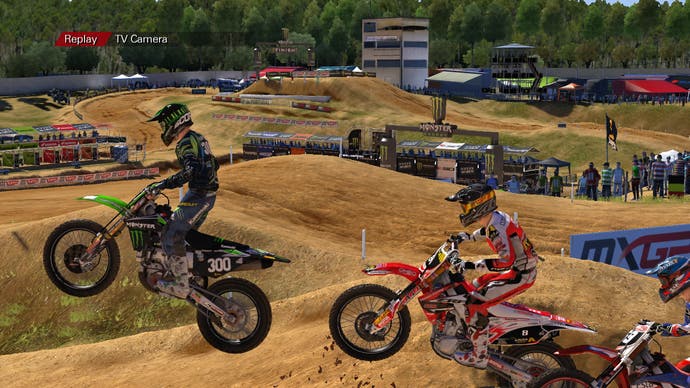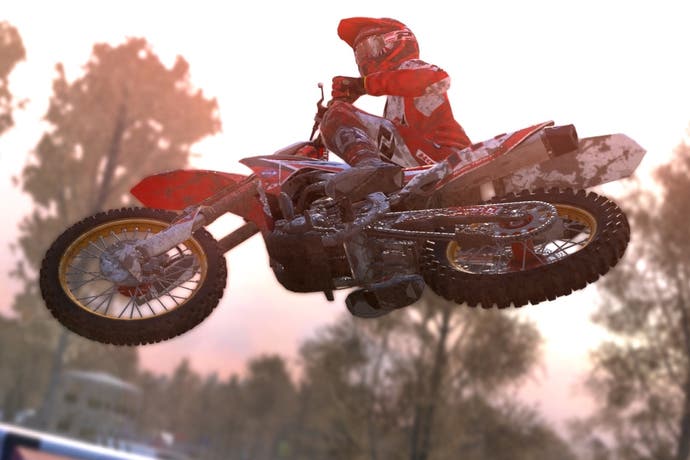MXGP: The Official Motocross Videogame review
Berm rubber.
With well over 10 motorcycle racing games to its name, Milestone is nothing if not experienced in the world of virtual counter-steering. Primarily, this Italian studio has focused its attentions on road racing - MotoGP and the Superbike World Championships - but with MUD back in 2012, Milestone traded in the knee-sliders for a pair of motocross goggles. The result was an arcade racer that wasn't about simulating the complexities of keeping a 450cc missile upright through a trench-like hairpin so much as it was about boosting down a straight with the aid of an energy drink.
With MXGP, Milestone has ditched the gimmicks in favour of a more authentic motocross experience. It's clearly built upon the MUD foundation, but while that game represented motocross in the same way that SSX portrays real-life snowboarding, MXGP invites you to respect the fundamentals of the sport. It does this through three gradients of riding physics: Base, Medium and Pro. As you'd expect, Base is the least demanding and lets you off with the odd overcooked corner or poorly landed jump. But while MUD made crashing a rarity, MXGP conveys a greater sense of temperamental traction.
Despite being an avid biker who's owned everything from a two-stroke Yamaha TZR125R to a hefty Kawasaki ZX-12R Ninja, my first-hand experience of motocross bikes is fairly limited. I've torn across a makeshift circuit (aka a field) a couple of times on a borrowed pair of wheels, but I'm in no position to judge how accurately MXGP replicates the art of motocross. What I do know for certain, however, is that this isn't MotoGP 13 with slippery handling. With the physics set to Pro and the rider weight set to manual, you have to tackle every corner, jump and berm with an entirely different mindset.
One thing that MXGP does poorly is teaching the nuances of motocross racing to the player. You'd arguably learn more from watching a real-life tutorial on YouTube than relying on the game's five instructional videos. They give a brief overview of the basics, but this game would really benefit from a fleshed-out school mode. That being said, once the various techniques start to fall into place and you learn to shift the rider's weight with the right analogue stick and flatten the bike's airborne trajectory with a well-timed whip, there's a genuine sense of accomplishment as you become a better rider both on the ground and in the air.

Riding physics have always been Milestone's strong suit and MXGP continues the trend. Unfortunately, it also suffers from the studio's longstanding weakness - workmanlike visuals. There are so many games out there that manage to circumvent the need for lavish graphics with raw style, but when MXGP strives for a semblance of realism with a tepid attitude and a lighting engine that wouldn't look out of place on the PlayStation 2, it can't help but look decisively dated.
Another issue that's hard to overlook is the complete lack of in-game music, an omission that seems strange given the game's uncompromising price point, but at least no shortcuts have been taken in terms of manufacturers and livery. You can ride as seven-time world champion Antonio Cairoli on his KTM 450 SX-F or Shaun Simpson on his Yamaha YZ450RM - just don't expect much individuality between the big names as the handling is fairly uniform.
This lack of distinguishing features is something that's also true of the Career mode. I've lost count of the number of times I've journeyed from wildcard to champion in a Milestone career mode, and if you've ever completed back-to-back race weekends in an SBK game, then MXGP serves up a very similar experience. It doesn't let you tinker with the bike's settings to quite the same degree and you can't streamline the customisation process by answering multiple choice questions, but in everything from the basic rider creation options and unlockable helmets to the Social Feed feature that generates comments from a simulated fan-base, this is everything we've come to expect from Milestone.
While Milestone's lack of budget is normally balanced by the force of its passion, MXGP feels a little too flat for a sport that's all about high-flying attitude

There are no surprises in the available modes, either. Instant Race lets you get down and dirty with a randomised track and rider; Grand Prix lets you tailor the race to your exact specification; Championship lets you pick your favourite tracks for a full race season; and Time Attack lets you explore the best entry, exit and landing points without the hindrance of other riders. Milestone is also claiming 1:1 accuracy for all 14 tracks. Having never been to Maggiora in Italy or even Matterly Basin in Winchester, it's hard to say how accurate this claim is, but going by Milestone's track record with the SBK series, the layout is probably as authentic as it's going to get.
Rounding off this somewhat complacent package are the online modes. Up to 12 players can compete in a single race or (if you have a lot of spare time on your hands) a complete championship. There's also a fairly comprehensive leaderboard that keeps track of the best lap times for each track and class. The netcode does a reasonable job of keeping up with the action so long as you keep it within your time-zone. And if you're planning to approach MXGP with a casual attitude, you need to be mindful that, more often than not, the competition is well versed in the art of motocross.
If the SBK and MotoGP games can maintain a solid following with road racers, then there's no reason why MXGP can't do the same with motocross enthusiasts. After all, there aren't many games that challenge you to wheelie across a whoop while maintaining your balance. But while Milestone's lack of budget is normally balanced by the force of its passion, MXGP feels a little too flat for a sport that's all about high-flying attitude. The physics engine, as always, is the main attraction - it's just a shame that Milestone didn't apply a little more drive and ambition.

